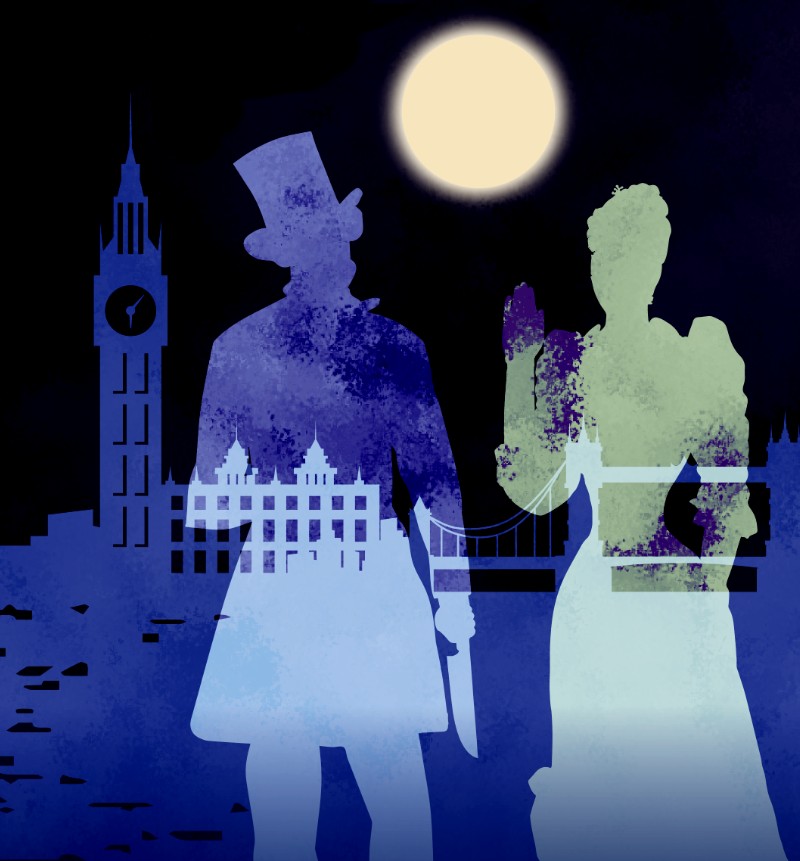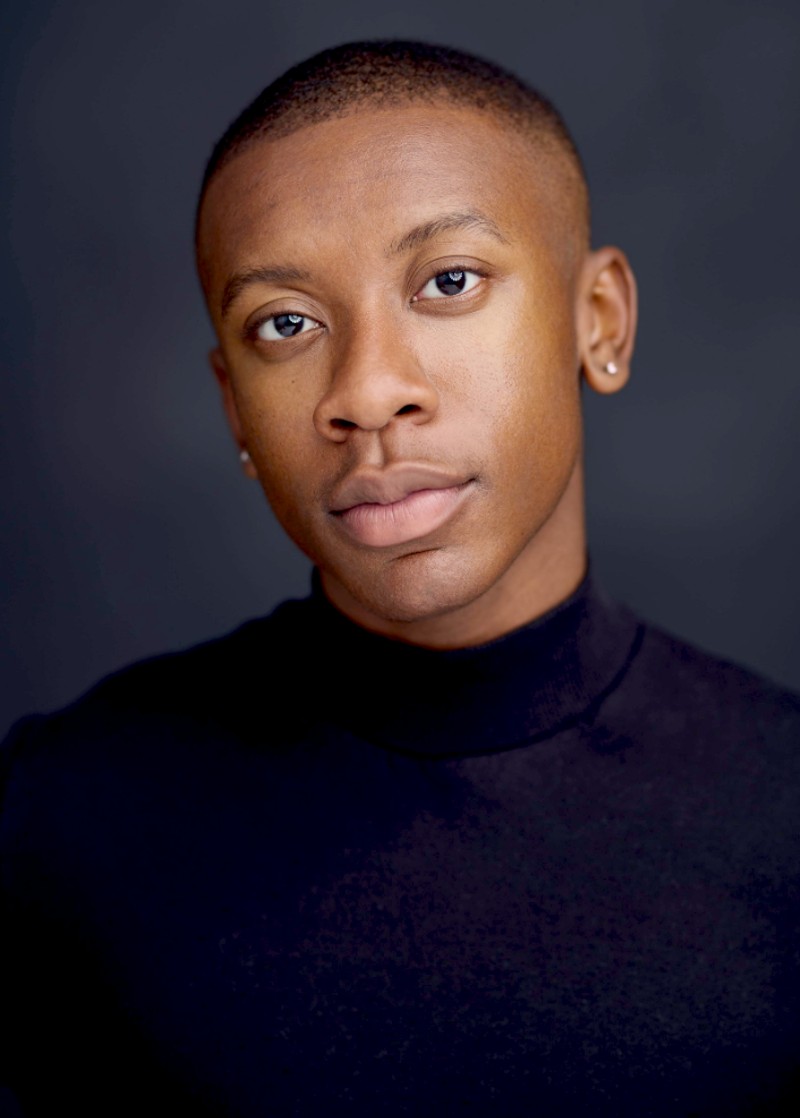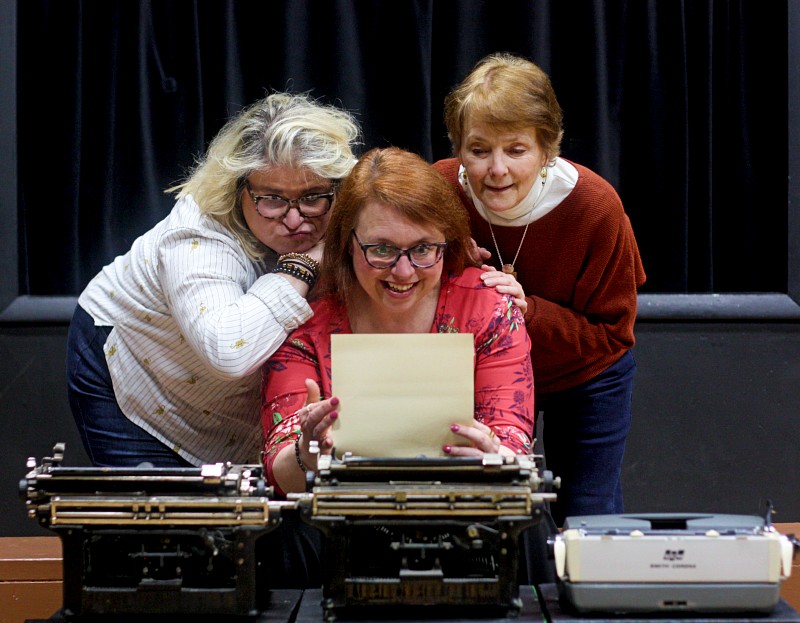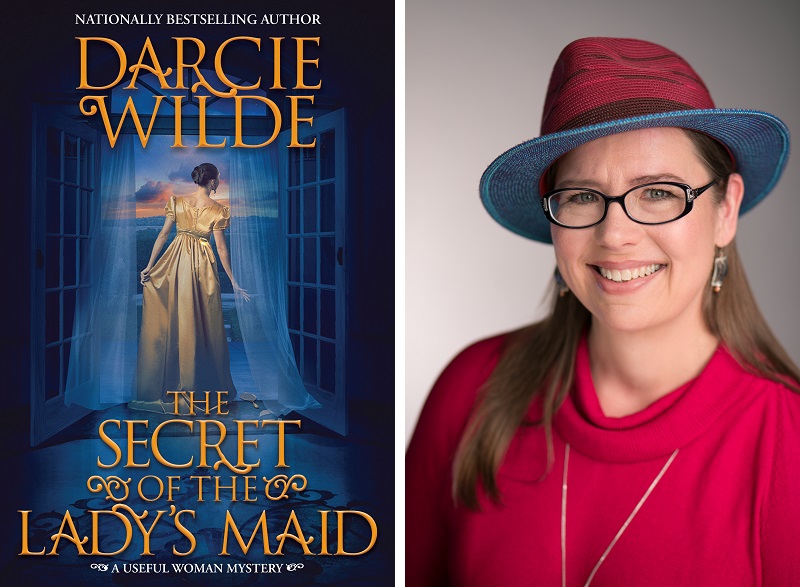Through the Grisly Maze: "Elizabeth Cree" is a puzzle-filled operatic mystery

As the opera begins, Elizabeth is hung for the murder of her husband, the playwright John Cree.
Is she guilty of poisoning him?
John is a serial killer, in the fashion of Jack the Ripper.
Or is he?
You’ll have about an hour and a half to solve the puzzles in Elizabeth Cree, which unravel in 29 scenes and over four timelines and include plays and vaudeville within an opera.
“It’s an interesting and complicated piece,” says Gregory Keller, who directs Unversity of Michigan opera students in this one-act chamber opera, sung in English, that runs March 21-24 at the Lydia Mendelssohn Theatre. Likening it to a hedge maze, he says, “We’re presenting it as a theatrical puzzle, a house of mirrors that the audience gets lost in and, maybe, found in. Each time you go into the maze, you make another connection.”
It’s so much so that conductor Kirk A. Severtson, who coordinates opera at U-M, says audiences who see it twice will delight in discovering Easter eggs, once they know what happened. “You have to see it more than once to get all the nuances,” he says.
But those who see it once will have a chance to figure out just what is happening, after observing three gruesome murders almost in front of their eyes: Keller opted to stylize the crimes, presenting them as Victorian shadow plays.
The Acting Office: Andrew Otchere turned his University of Michigan studies into the comedy "Becoming BFA: The Showcase Showdown"

Sometimes the most challenging part of a creative project is figuring out the best means of communicating a story to an audience.
In the case of Becoming BFA: The Showcase Showdown, creator Andrew Otchere—who graduated from the University of Michigan last spring with a degree in acting—initially thought he and a handful of student collaborators would be writing a television pilot when they gathered during their junior year.
“Then, as we talked about the concept, one aspect that became most important to me was that I really wanted to create something that would build a stronger community within my class of actors,” said Otchere, who just recently moved to Los Angeles (where he’s auditioning and writing). “I wanted to make sure that everybody was included. … By our senior year, there were about 18 of us … so it became a little too much to just be a pilot episode. There would be too many characters.”
So this would-be pilot episode became a short film that ran nearly 40 minutes.
But that wasn’t the final word on the project’s format, either. As Otchere submitted BFA to film festivals—it landed a screening at the Laughs After Dark Comedy Festival in Las Vegas—he started getting feedback that pointed him in a different direction entirely.
“One of the best pieces of advice I got was about how we are currently in the height of the digital age, where TikTok and short-form video has taken control,” Otchere said. “And being a story that focuses on the Gen Z perspective, which the target audience is also in … it only made sense to make episodes that are shorter, so we could put it out on TikTok, or create a mini web series of it. So that inspired me to cut [the film] up into nine five-minute episodes. And since it took form as a web series, it just felt like it was received so much better. People were excited for new episodes and gave a lot of feedback.”
The seed for making Becoming BFA—which focuses on students preparing for their Senior Showcase, when they get to perform in front of entertainment industry professionals—took root in Otchere’s freshman year (2019-20), when he and his fellow student actors joked about feeling like they were living in a reality show.
Six-Pack of Shorts: Ann Arbor Civic Theatre tackles David Ives' comedy anthology "All in the Timing"

When Bruce Morey was looking for a play to direct for the Ann Arbor Civic Theatre, he wanted a comedy that would engage a large cast and that wouldn’t be too time-consuming for cast members. Instead of one play, Morey found six plays in one package, David Ives’ All in the Timing.
“I wanted to do a comedy that didn’t have any heavy issues about it, just fun,” he said. “All in the Timing is a series of 10-minute plays and I wanted to explore 10-minute plays, which I think is great for community players because you can put a lot of people into these plays if you do it right. They’re shorter, so for people who work full time and have lives outside of theater, this is a great experience for them because they can come in and do a 10-minute play or a 15-minute play and maybe it’s their first experience with it. It’s self-contained and ideal for community players.”
The Ann Arbor Civic Theatre will present Ives’ six-pack of short comedies, March 14-17 at the Arthur Miller Theatre in Ann Arbor.
Director Morey and producer Nicole Arruda are working together on producing and directing.
Ypsilanti Author Darcie Wilde Continues Character Rosalind Thorne’s Detective Work in the Cozy Mystery, “The Secret of the Lady’s Maid”

Rosalind Thorne launches an investigation when Marianna Levitton hires her to find out the cause of her poisoning in the cozy mystery called The Secret of the Lady’s Maid by Darcie Wilde. As the plot unfolds, the attempted murders by arsenic are just the start of problems that expand to include jewel theft and murders.
This book is the second in the series called “The Useful Woman Mysteries,” which begins with The Secret of the Lost Pearls and features Rosalind, who's the main character in other novels by Wilde.
Wilde is one of several pseudonyms for University of Michigan alum and Ypsilanti-based author Sarah Zettel. Her period novels take place in Regency London, where the haut ton socialize and those in domestic service wait on them.
Rosalind possesses a keen eye for details that do not line up. Through observing people and delicately asking the right questions, she pieces together the story. As she is talking with Cate, a member of the Levitton family that Rosalind is scrutinizing, Rosalind displays her cleverness and discretion when she asserts:
The Archivist's Tale: Evan Haywood Digs Through His Past to Help Define His Musical Future On New Live Album

Evan Haywood remembers his first live solo show at Canterbury House in 2014.
The producer, musician, songwriter, rapper, visual artist, filmmaker, and digital archivist recalled feeling nervous about sharing vulnerable folk songs and playing a nylon-string guitar at the Ann Arbor venue.
“It was such a jarring experience almost to go from performing in sweaty clubs and bars where everybody’s dancing … and having a good time to this very stark, acoustic performance where I’m baring my soul,” said Haywood, a University of Michigan alumnus who had previously performed live with the local hip-hop group Tree City.
“I feel like that performance was some sort of watershed moment for me because I had to prove to myself that I could do it. I had never done a performance like that with just an acoustic guitar and myself.”
Fortunately, Haywood’s intimate performance was recorded on cassette by Fred Thomas and initially released on limited-edition tape through Thomas’ Life Like label in 2015. Today, part of that performance now appears on Haywood’s latest live album, Canterbury Tales.
“I spent the past 10 years or so honing them and working on the mixes and cleaning up some of the noise and things like that to get them to the point they’re at now,” Haywood said.
“When you’re dealing with tape, you have fewer options, so you really have to work in a detailed way to be able to massage those recordings and get the good stuff out and take some of the noise down. That’s something I’ve been tinkering with—those Canterbury House recordings—and I feel like now my tinkering is done.”
U-M law professor Barbara McQuade fights against disinformation in her new book

When Barbara McQuade, a University of Michigan law professor and MSNBC legal analyst, prosecuted a doctor who “cured” cancer in patients who didn’t have cancer, some victims refused to believe they’d been duped. They had trusted their doctor, after all, and how could they have been so wrong?
In her new book, Attack From Within: How Disinformation Is Sabotaging America, which she will discuss at the Ann Arbor District Library on March 7, McQuade uses many examples from history, here and abroad, to show us just how disinformation works.
In her comprehensive page-turner, McQuade also pulls theories from top political scientists, stories from FBI agents and other experts, and even Greek mythology, weaving them into a coherent argument that just may save our democracy.
The Amplify Project and Spin Inc. Bring Detroit Electronic Music Conference to Washtenaw Community College on March 2

After the Detroit Electronic Music Conference was put on hold last year due to a lack of venue, Rod Wallace and Ron “DJ Jungle” Johnson decided to bring the music production and DJ education event to Washtenaw County.
The heads of music nonprofits the Amplify Project and Spin Inc. will co-host the Detroit Electronic Music Conference (or “D Mack”) on March 2 at Washtenaw Community College’s Morris Lawrence Building.
“I first met DJ Jungle, who’s the executive director of Spin Inc., at a meeting with Grove [Studios], and they were looking for some opportunities to partner. Spin Inc. came and participated in our TAP IN event in 2023 and we talked about how we could collaborate,” said Wallace. about the free conference, which takes place March 2 and last occurred at the now-defunct Detroit Institute of Music Education in 2022.
“We had a conversation about his interest in bringing back the ‘D Mack,’ and I said, ‘Well, listen, we have a great partner in WCC … and [we can] tie it in with the arts management coursework that we’re teaching.’”
As part of D Mack’s preparations, the Amplify Project and Spin Inc. have enlisted WCC arts management students to help run the conference since their capstone class is built around event creation, collaboration, and execution.
Poet Zilka Joseph imparts memories, history, and culture of the Bene Israel people by way of food in “Sweet Malida”

“From tumbled sands and shattered bark / blurred shadows dragged us,” writes Zilka Joseph in her new poetry collection, Sweet Malida: Memories of a Bene Israel Woman.
These poems are immersed in the history, customs, and food of the Bene Israel people. The Ann Arbor poet shares about their shipwreck on the shores of India, worship of the prophet Elijah, and subsequent dispersing across the world. While Joseph imparts facts about the culture and community, she also makes the poems personal with her memories.
This cultural and familial history informs Joseph’s poems, such as “Leaf Boat,” which is a longer poem that receives its own section of the book. Joseph describes “my body a leaf boat / lamp floated on water” in the context of the heritage of her ancestors, grandmother, parents, and herself who moved from place to place. Even her birth was during unsettled weather: “I was born Thursday in monsoon rain / night time East coast time / in Bombay a baby opens her eyes.” Water, especially oceans, flows through the lines, and “in my dream / the whales are singing.”
Joseph focuses less on what is lost, though she does pay tribute to her parents, and focuses more on the richness that the traditions and foods of the Bene Israel pass along. One such food is “draksha-cha sharbath. Sherbet of raisins” for Shabbath, which Joseph writes about replicating on her own after moving to the United States. Earlier, she had prepared it with her grandmother and mother. As she writes in one of the short essays or prose poems that are interspersed throughout the book, making this recipe is like time traveling for Joseph:
A Jill of All Trades: Julia Garlotte takes the helm of The Penny Seats Theatre Company

A theater's artistic director has to oversee everything on stage. She also has to check in with financial managers so the production stays on budget, and she has to understand acting, directing, and design—the whole deal.
Julia Garlotte, the new artistic director (AD) of The Penny Seats Theatre Company, is the whole deal.
Garlotte has acted for The Purple Rose in Chelsea, The Encore Musical Theatre Company in Dexter, and Penny Seats in Ann Arbor as well as at some of the town's lost theaters: The Performance Network, The Blackbird, and The New Theatre Project. Audiences have seen her at other theaters throughout Southeast and Central Michigan, too.
She has also designed sound for several theaters, recorded audiobooks, and recently she’s been directing.
Oh, and Garlotte managed the box office at The Purple Rose for 12 years.
The “sheer volume of her professional experiences” is one of the things that impresses Penny Seat’s outgoing AD, Joseph Zettelmaier.
In addition to working with Penny Seats as an actor, she's also been a sound designer, sound engineer, assistant director, and director for the company.
Clear and Present: Darrin James looks at marriage, family, and loss on “See Right Through”

When it comes to writing about love and loss, Darrin James believes in being crystal clear.
The Ann Arbor singer-songwriter and producer shares honest and vulnerable stories about marriage, family, death, and uncertainty on his latest album, See Right Through.
“A lot of people say it’s heart-on-your-sleeve. I think that’s true and it’s always how I’ve kinda written. This album came from the more reflective side of things, and you have to embrace the vulnerability to write an honest song,” said James, who plays guitar, piano, organ, and synth on his fourth full-length release.
“Sometimes those tropes can express really true feelings … and sometimes when you’re being honest, a song is easier to write. It comes out more like a diary … and you’re staring at it thinking, ‘Now that it came out of me, that’s the song—it’s done.’”
On See Right Through, James reveals a gamut of emotions ranging from gratitude to joy to grief to hopelessness across seven tracks. Those raw feelings come to life through the album’s personal lyrics, heartfelt roots-rock instrumentation, and dreamy synth and horn textures.
“Those were personal songs that I waited until I had [them], and it made more sense after I had the love songs to counter the sad songs. I thought, ‘Now the whole album can have an arc of not just being a sad story,’” he said.
“Because [the songs] are more personal, they’re also more universal and timeless … Those themes I’m trying to deal with are ones that everyone [experiences].”


































